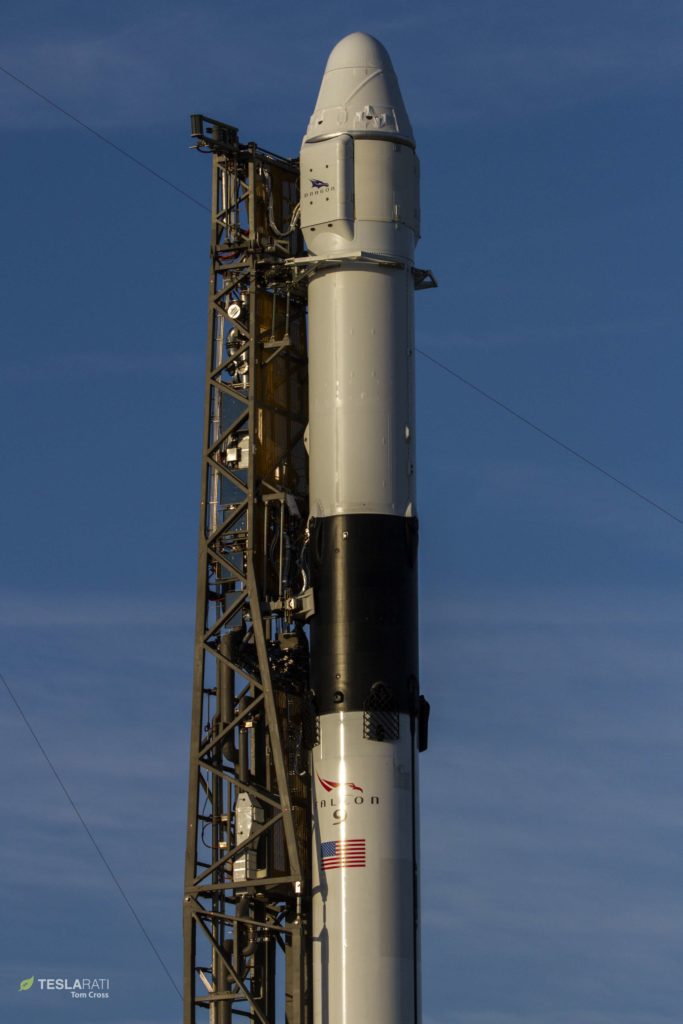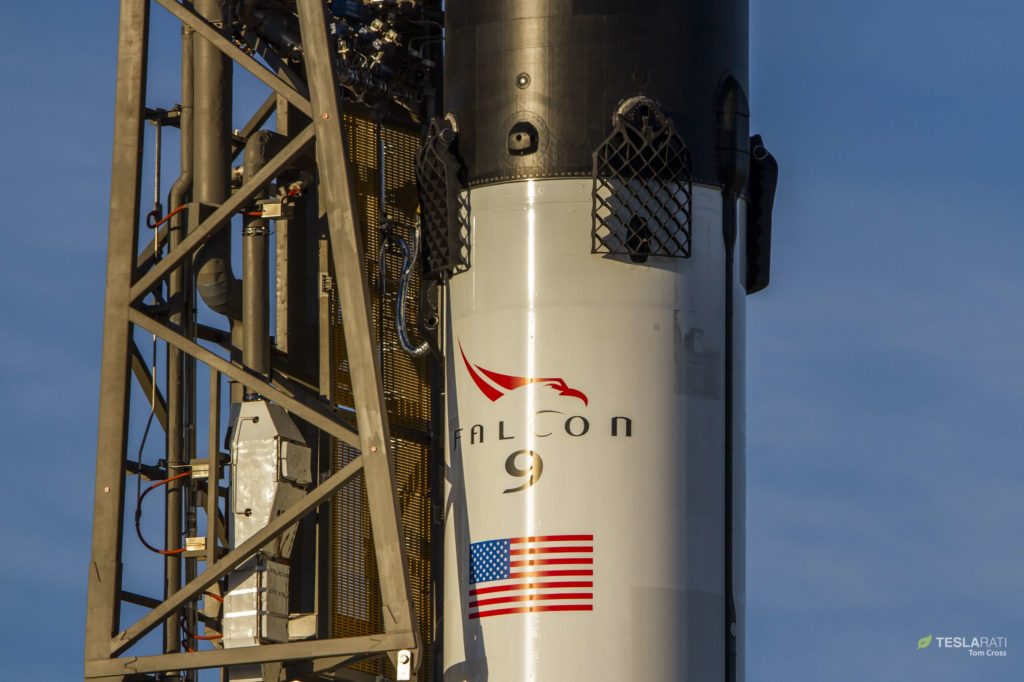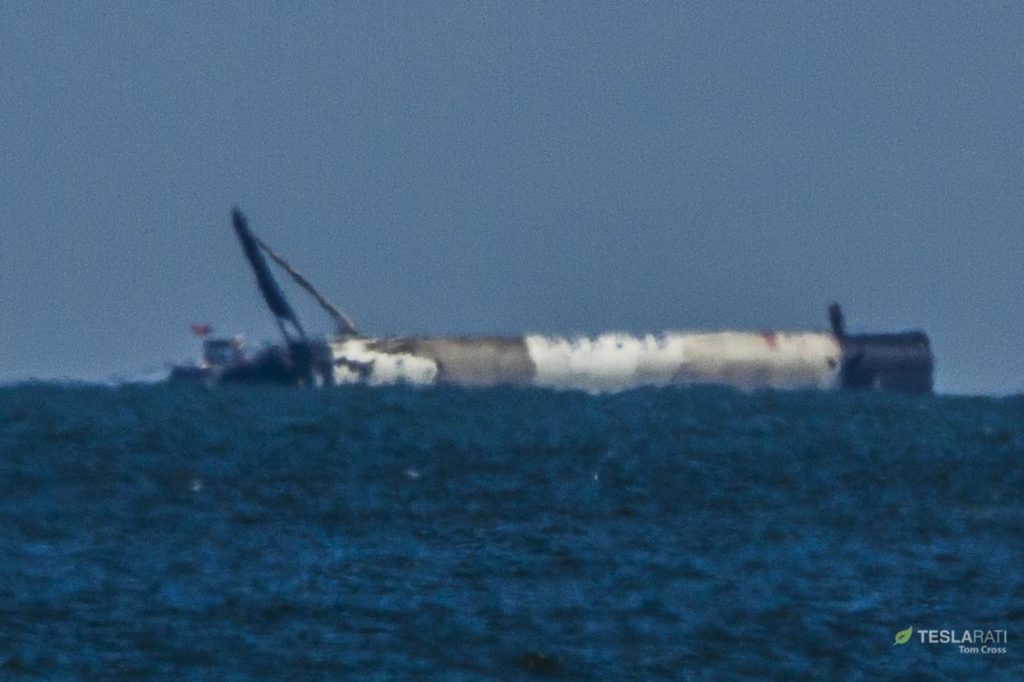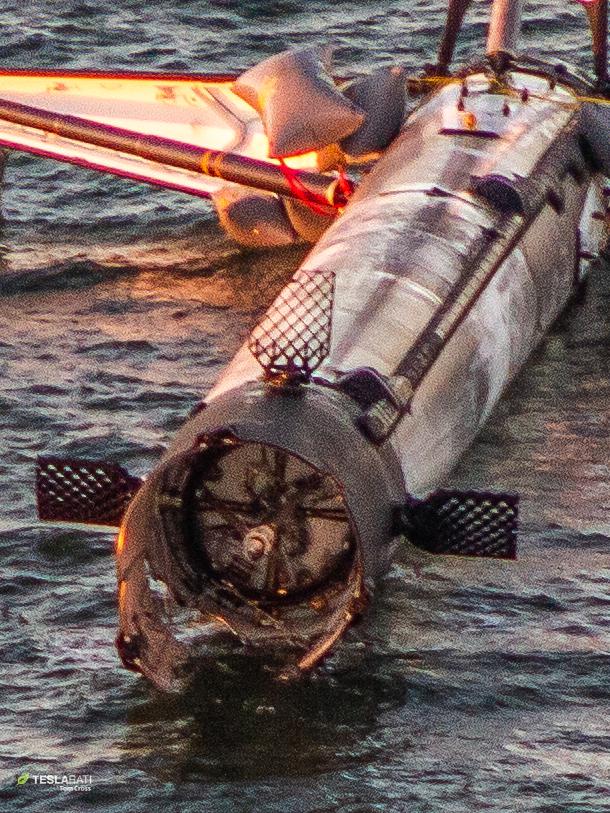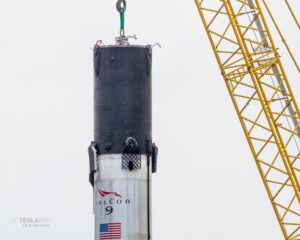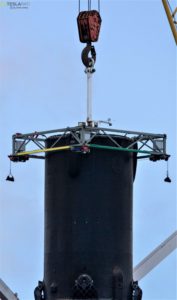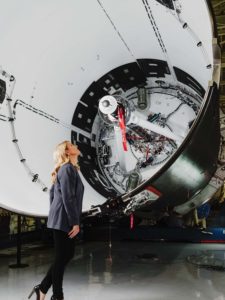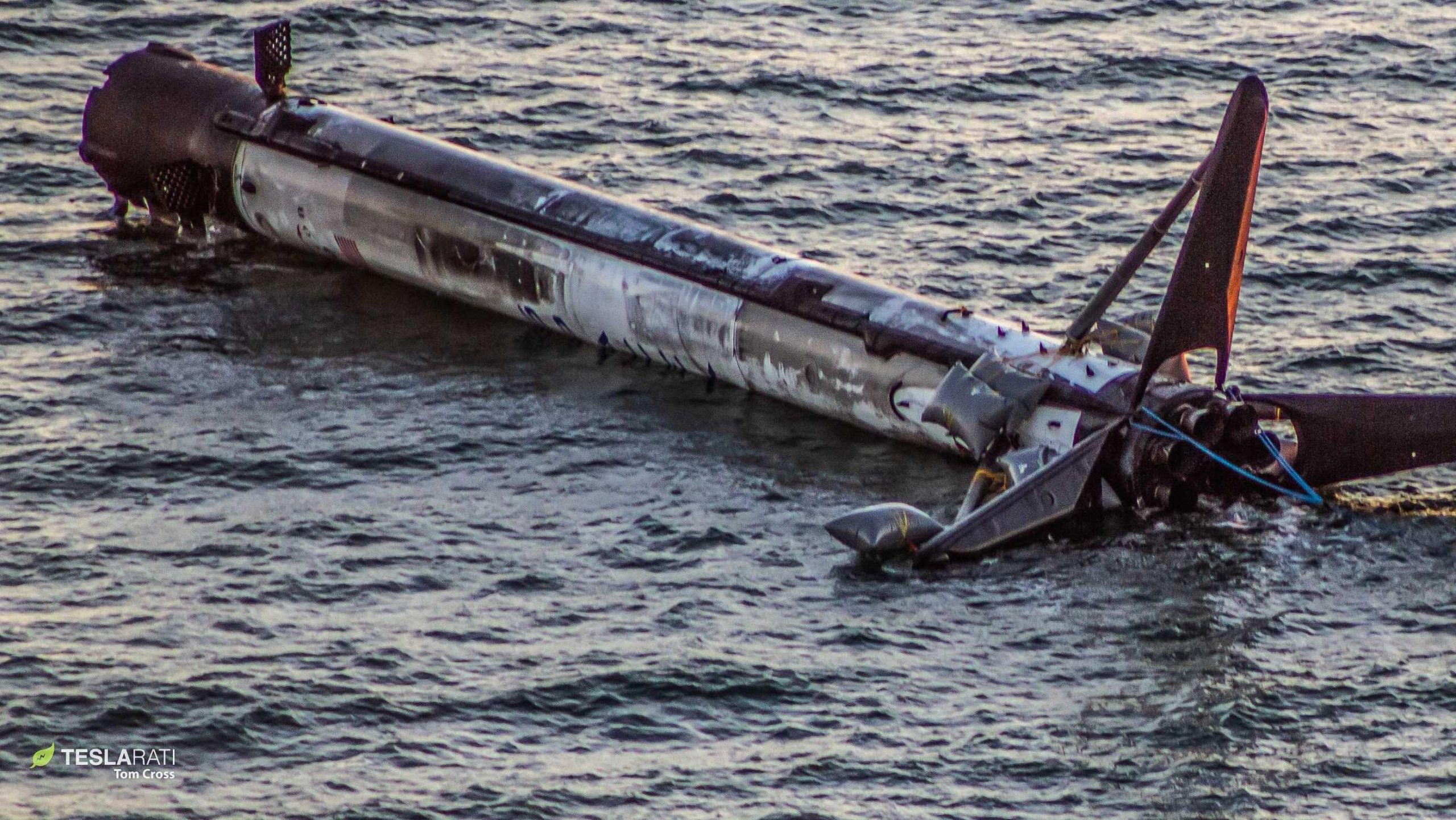
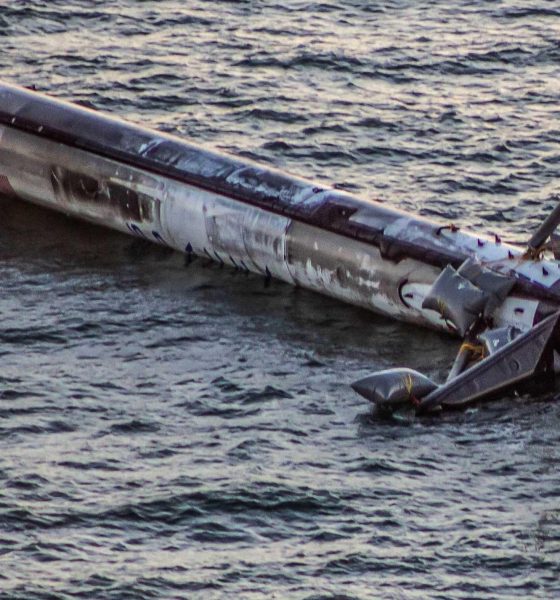
SpaceX
SpaceX’s first Falcon 9 Block 5 booster casualty battered but still intact in aerial photos
Shortly after successfully sending a reused Cargo Dragon spacecraft on its way towards the International Space Station (ISS), SpaceX Falcon 9 Block 5 booster B1050 experienced an anomaly with its grid fins during a planned landing, resulting in a shockingly soft (but unintentional) landing just off the Florida coast.
By some minor miracle, the drastically off-nominal loads experienced by the booster during its unintended departure from controlled flight somehow did not rise to the bar of structural failure. Nevertheless, now floating a handful of miles east of Port Canaveral’s mouth, B1050 did not make it through the ordeal unscathed.
https://twitter.com/_TomCross_/status/1070742919986991107
A little more than 24 hours after the booster found itself floating sideways in the Atlantic Ocean, B1050 had floated a solid ten miles south of its original position into waters and airspace that no longer fell under the purview of Cape Canaveral Air Force Station, technically a military outpost. As the captains of tugboat Eagle and SpaceX support vessel GO Quest discussed the logistics of returning the booster to port with the local harbormaster and US Coast Guard, Teslarati photographer Tom Cross chartered a local helicopter to get a slightly better view of the waterlogged rocket and its ad-hoc recovery operations.
A casualty of war (with the air)
Second only to the fact that the booster appears to be in disproportionately good shape considering the circumstances, by far the most noteworthy feature of the newest addition to SpaceX’s marine fleet is the sheer damage suffered by B1050’s interstage, the black carbon fiber composite structure that topsFalcon 9 Block 5 boosters and hosts its grid fins and stage separation mechanism.
Revealed from an aerial perspective, it almost looks as if one side of the composite cylinder was smashed with a giant hammer, tearing off at least 20% of the entire interstage – including one of four titanium grid fins – while leaving another large segment hanging on by only partially-figurative carbon fiber threads.
- Falcon 9 B1050 is seen here shortly before launch with an intact interstage. (Tom Cross)
- B1050 viewed from Cocoa Beach. (Tom Cross)
- Falcon 9 B1050’s interstage, or what’s left of it. (Tom Cross)
- RIP grid fin. (Tom Cross)
It’s not 100% clear why B1050’s interstage was so readily destroyed but a narrative can certainly be drawn from the current public record. After its grid fins lost hydraulic power and became stuck at an extreme angle, B1050 almost immediately lost control and began rapidly and quite brutally spinning and flailing, tossed around as it hurtled through the air at supersonic speeds. Being a predominately smooth cylinder, Falcon 9’s first stage is inherently prone to rotation in the presence of high-velocity air currents, which is why its grid fins are an absolute necessity for maintaining control authority during in-atmosphere “flights”.
Engines stabilized rocket spin just in time, enabling an intact landing in water! Ships en route to rescue Falcon. pic.twitter.com/O3h8eCgGJ7
— Elon Musk (@elonmusk) December 5, 2018
In a show that will turn the stomach of anyone familiar with a rocket’s typically narrow load tolerances, Falcon 9 B1050 experienced extreme aerodynamic stresses during the worst of its uncontrolled tumble, to the extent that the entire booster and interstage can be seen visibly twisting at least 5 degrees left and right from the perspective of an onboard camera. In the video above, focus on the center of Falcon 9’s grid fins during the first and last 5-10 seconds to properly visualize the extreme forces at play.
It might look fairly innocent to the untrained eye, but keep in mind that Falcon 9’s interstage is no more than a couple of inches thick and is absolutely massive, stretching 3.7m (~12 ft) in diameter. Perhaps even more importantly, the damage to the interstage has almost without a doubt rendered it unusable from the perspective of SpaceX’s established methods of safely moving and manipulating Falcon 9 boosters.
- Technicians attach an older interstage-grabber to lift B1046 after its first recovery. (Tom Cross)
- One of SpaceX’s East Coast interstage jigs is pictured here atop B1049. (Tom Cross)
- A Falcon 9 Block 5 booster bares its interstage and pusher rod, offering a perfect illustration of its scale. (Bloomberg)
All of those methods rely on adapters that attach to the interstage to lift the rocket vertically or support part of its ~30-ton dry mass horizontally. Lacking a sound interstage, it’s now entirely unclear how SpaceX might go about getting B1050 onto land without damaging it further. In simpler terms, this bodes very, very badly for any plans to safely reuse B1050 in the near (or distant) future. After suffering loads that severely weakened and ultimately tore its interstage to pieces, it’s reasonable to assume that the rest of the rocket’s lithium-aluminum propellant tanks experienced stresses that are at least roughly comparable.
If that’s the case, perhaps the only real hope for B1050’s ‘reuse’ will be the recovery of certain subcomponents and miscellaneous parts that may have made it through the ordeal unscathed or with only minor damage. The three remaining titanium grid fins are a guaranteed recovery, while COPVs, cold gas thrusters, avionics boxes, and maybe even some of its nine Merlin 1D engines could be salvageable with some level of refurbishment.
In the meantime, the tentative plan right now is to two B1050 into Port Canaveral sometime after dawn tomorrow, either ending up at drone ship OCISLY’s berth or another less-developed section of the port.
For prompt updates, on-the-ground perspectives, and unique glimpses of SpaceX’s rocket recovery fleet check out our brand new LaunchPad and LandingZone newsletters!

Elon Musk
Starlink passes 9 million active customers just weeks after hitting 8 million
The milestone highlights the accelerating growth of Starlink, which has now been adding over 20,000 new users per day.

SpaceX’s Starlink satellite internet service has continued its rapid global expansion, surpassing 9 million active customers just weeks after crossing the 8 million mark.
The milestone highlights the accelerating growth of Starlink, which has now been adding over 20,000 new users per day.
9 million customers
In a post on X, SpaceX stated that Starlink now serves over 9 million active users across 155 countries, territories, and markets. The company reached 8 million customers in early November, meaning it added roughly 1 million subscribers in under seven weeks, or about 21,275 new users on average per day.
“Starlink is connecting more than 9M active customers with high-speed internet across 155 countries, territories, and many other markets,” Starlink wrote in a post on its official X account. SpaceX President Gwynne Shotwell also celebrated the milestone on X. “A huge thank you to all of our customers and congrats to the Starlink team for such an incredible product,” she wrote.
That growth rate reflects both rising demand for broadband in underserved regions and Starlink’s expanding satellite constellation, which now includes more than 9,000 low-Earth-orbit satellites designed to deliver high-speed, low-latency internet worldwide.
Starlink’s momentum
Starlink’s momentum has been building up. SpaceX reported 4.6 million Starlink customers in December 2024, followed by 7 million by August 2025, and 8 million customers in November. Independent data also suggests Starlink usage is rising sharply, with Cloudflare reporting that global web traffic from Starlink users more than doubled in 2025, as noted in an Insider report.
Starlink’s momentum is increasingly tied to SpaceX’s broader financial outlook. Elon Musk has said the satellite network is “by far” the company’s largest revenue driver, and reports suggest SpaceX may be positioning itself for an initial public offering as soon as next year, with valuations estimated as high as $1.5 trillion. Musk has also suggested in the past that Starlink could have its own IPO in the future.
News
SpaceX shades airline for seeking contract with Amazon’s Starlink rival

SpaceX employees, including its CEO Elon Musk, shaded American Airlines on social media this past weekend due to the company’s reported talks with Amazon’s Starlink rival, Leo.
Starlink has been adopted by several airlines, including United Airlines, Qatar Airways, Hawaiian Airlines, WestJet, Air France, airBaltic, and others. It has gained notoriety as an extremely solid, dependable, and reliable option for airline travel, as traditional options frequently cause users to lose connection to the internet.
Many airlines have made the switch, while others continue to mull the options available to them. American Airlines is one of them.
A report from Bloomberg indicates the airline is thinking of going with a Starlink rival owned by Amazon, called Leo. It was previously referred to as Project Kuiper.
American CEO Robert Isom said (via Bloomberg):
“While there’s Starlink, there are other low-Earth-orbit satellite opportunities that we can look at. We’re making sure that American is going to have what our customers need.”
Isom also said American has been in touch with Amazon about installing Leo on its aircraft, but he would not reveal the status of any discussions with the company.
The report caught the attention of Michael Nicolls, the Vice President of Starlink Engineering at SpaceX, who said:
“Only fly on airlines with good connectivity… and only one source of good connectivity at the moment…”
CEO Elon Musk replied to Nicolls by stating that American Airlines risks losing “a lot of customers if their connectivity solution fails.”
American Airlines will lose a lot of customers if their connectivity solution fails
— Elon Musk (@elonmusk) December 14, 2025
There are over 8,000 Starlink satellites in orbit currently, offering internet coverage in over 150 countries and territories globally. SpaceX expands its array of satellites nearly every week with launches from California and Florida, aiming to offer internet access to everyone across the globe.
Currently, the company is focusing on expanding into new markets, such as Africa and Asia.
News
Tesla hints at Starlink integration with recent patent
“By employing polymer blends, some examples enable RF transmission from all the modules to satellites and other communication devices both inside and outside the vehicle.”

Tesla hinted at a potential Starlink internet terminal integration within its vehicles in a recent patent, which describes a vehicle roof assembly with integrated radio frequency (RF) transparency.
The patent, which is Pub. No U.S. 2025/0368267 describes a new vehicle roof that is made of RF-transparent polymer materials, allowing and “facilitating clear communication with external devices and satellites.”
Tesla believes that a new vehicle roof design, comprised of different materials than the standard metallic or glass elements used in cars today, would allow the company to integrate modern vehicular technologies, “particularly those requiring radio frequency transmission and reception.
Tesla has recently filed a US patent application on integrating RF transparent materials into the roof structure.
“facilitating clear communication with external devices and satellites”
Tesla fleet is getting @Starlink connectivity integration soon. LFG @Tesla @elonmusk… pic.twitter.com/bLa8YtPLd1
— Chansoo Byeon (@Chansoo) December 9, 2025
Instead of glass or metallic materials, Tesla says vehicles may benefit from high-strength polymer blends, such as Polycarbonate, Acrylonitrile Butadiene Styrene, or Acrylonitrile Styrene Acrylate.
These materials still provide ideal strength metrics for crashworthiness, stiffness for noise, vibration, and harshness control, and are compliant with head impact regulations.
They would also enable better performance with modern technologies, like internet terminals, which need an uninterrupted signal to satellites for maximum reception. Tesla writes in the patent:
“By employing polymer blends, some examples enable RF transmission from all the modules to satellites and other communication devices both inside and outside the vehicle.”

One of the challenges Tesla seems to be aware of with this type of roof design is the fact that it will still have to enable safety and keep that at the forefront of the design. As you can see in the illustration above, Tesla plans to use four layers to increase safety and rigidity, while also combating noise and vibration.
It notes in the patent that disclosed examples still meet the safety requirements outlined in the Federal Motor Vehicle Safety Standards (FMVSS).
Starlink integrated directly into Tesla vehicles would be a considerable advantage for owners. It would come with a handful of distinct advantages.
Initially, the inclusion of Starlink would completely eliminate cellular dead zones, something that is an issue, especially in rural areas. Starlink would provide connectivity in these remote regions and would ensure uninterrupted service during road trips and off-grid adventures.
It could also be a critical addition for Robotaxi, as it is crucial to have solid and reliable connectivity for remote monitoring and fleet management.
Starlink’s growing constellation, thanks to SpaceX’s routine and frequent launch schedule, will provide secure, stable, and reliable internet connectivity for Tesla vehicles.
Although many owners have already mounted Starlink Mini dishes under their glass roofs for a similar experience, it may be integrated directly into Teslas in the coming years, either as an upgrade or a standard feature.
